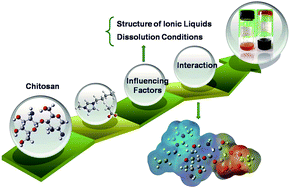The dissolution behaviour of chitosan in acetate-based ionic liquids and their interactions: from experimental evidence to density functional theory analysis†
Abstract
The searches for sustainable solvents of chitosan have drawn wide attention in recent years. In this study, nine acetate-based ionic liquids (ILs) varying in their cation are used to explore the dissolution behavior of chitosan and the interactions between IL and chitosan. The solubilities of chitosan in these ILs have been determined in the temperature range from 40 °C to 140 °C with 10 °C intervals. For the imidazolium-based ILs, the solution thermodynamic parameters of chitosan have been calculated from the solubility data. The effects of cation type, alkyl chain structure, temperature and water content on the dissolution were investigated. Hydrogen bond donating and accepting abilities of ILs have been estimated by 1H nuclear magnetic resonance (NMR) spectroscopy and solvatochromic ultraviolet-visible (UV-vis) spectroscopy probe measurements. Temperature dependence of 13C NMR spectra and density functional theory (DFT) computations show that both cations and the OAc− anion of ILs play significant roles in the chitosan dissolution process by the disruption of the inherent hydrogen bonds of chitosan. And the interchain hydrogen bonds may be disrupted prior to the intrachain hydrogen bonds in the process of chitosan dissolution. In addition, low ionicity and special hydrogen bond interactions are used to explain the low chitosan solubility in the four quaternary ammonium-based ILs.


 Please wait while we load your content...
Please wait while we load your content...